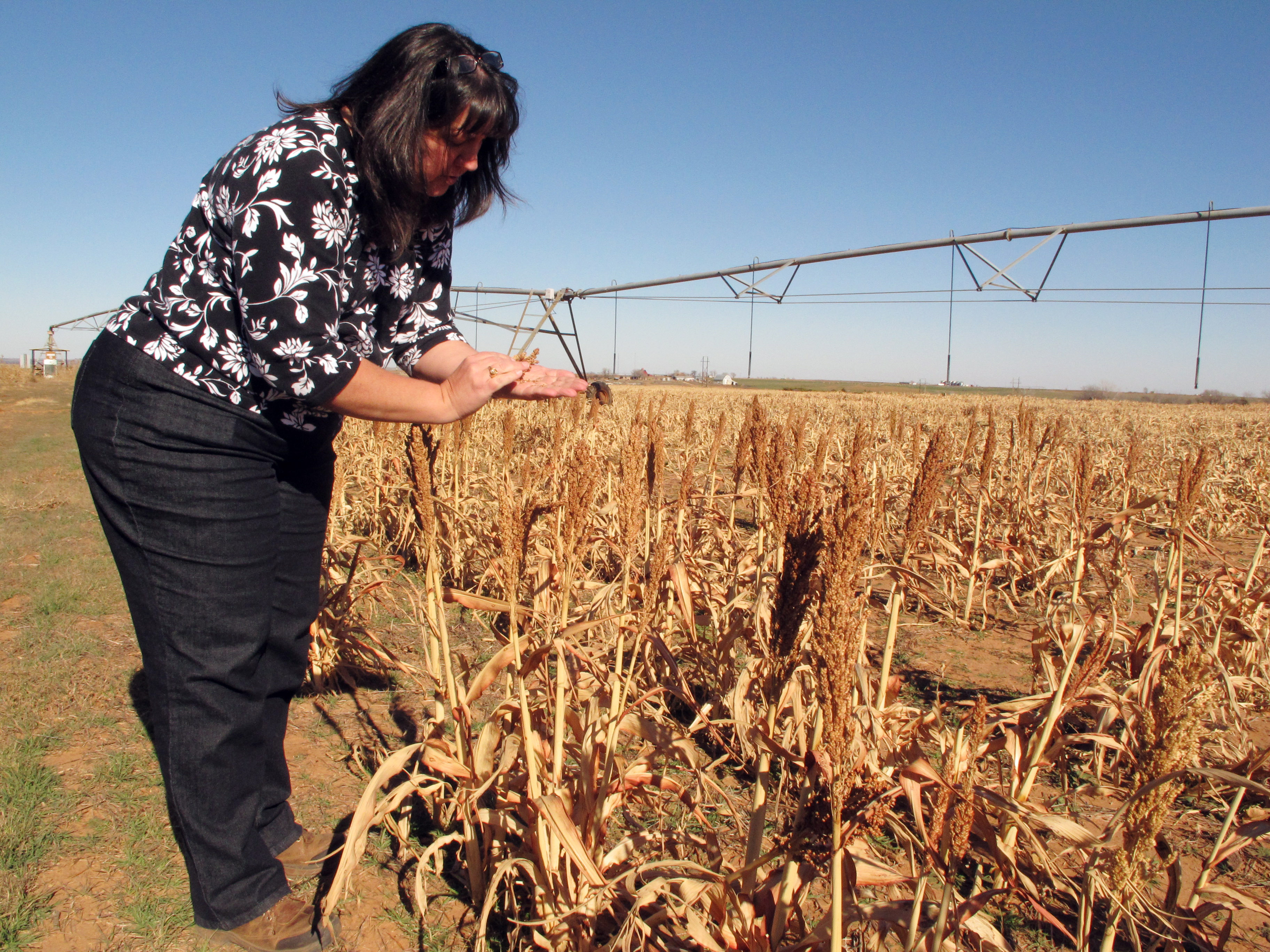 Caddo County, Okla., farmer Karen Krehbiel examines unharvested milo on her family's farm near Hydro, Okla. Not all of the farm's milo fields were irrigated because of an ongoing drought, the latest natural disaster to strike the county, which also has been beset in recent years by floods, tornadoes, ice storms and hail.
Caddo County, Okla., farmer Karen Krehbiel examines unharvested milo on her family's farm near Hydro, Okla. Not all of the farm's milo fields were irrigated because of an ongoing drought, the latest natural disaster to strike the county, which also has been beset in recent years by floods, tornadoes, ice storms and hail.BINGER, Okla. - In the gently rolling hills of Oklahoma ranch country is a place that has seen more than its share of destructive weather - tornadoes, ice storms and floods, year after year, for half of the last decade.
In fact, Caddo County has been declared a federal disaster area nine times since 2007, making it one of the nation's most ill-fated locations. But even here, farmers and ranchers say, no one has endured anything as crippling as the ongoing drought, which has dried out ponds, withered crops in the field and decimated the water table.
"It makes you become humble," said Charlie Opitz, who began his farming career selling peanut seeds in 1959 and grew his operation to more than 2,500 acres near the small town of Binger, about 60 miles west of Oklahoma City. "You realize there's something out there much greater than you are."
Oklahomans know better than most Americans about the perils of bad weather. Their state practically blew away during the Dust Bowl of the 1930s, and they live in the heart of tornado alley - a wide corridor in the central United States where twisters are common.
Caddo County has endured all that and more. Its recent history reads like a storm chaser's logbook or some punishment inflicted by a vengeful god.
The area was hit by no fewer than five federal disasters in 2007 alone, including ice storms, violent winds, tornadoes and flooding. Then the county suffered a disaster each year for the next four, including more tornadoes and flooding in 2008, a blizzard in 2009, another ice storm in 2010 and tornadoes and flooding again in 2011.
By comparison, the county suffered only five federal disasters during the entire decade of the 1990s.
Now comes the drought, a ceaseless dry spell that began last summer and could persist through much of 2013.
Rainfall totals for 2012 were more than 10 inches below normal, and the two-year total of 51 inches is the fourth-lowest since record keeping began in 1895, according to the Oklahoma Climatological Survey.
A few scattered showers have brought much-needed rain to the region in recent weeks, but the entire county remains locked in extreme drought conditions, according to the U.S. Drought Monitor, a government service.
Karen Krehbiel, who raises sheep and grows wheat and milo near Hinton, said her farm's utility expenses more than doubled from about $15,000 in 2010 to $33,000 in 2012, mostly because of increased costs to irrigate parched fields. Sheep that traditionally would graze on pasture land must be fed hay, making the operation still more expensive.
"Because it was so hot and dry, even running irrigation all day, you couldn't produce enough water," said Krehbiel, who had to let 30 acres of alfalfa die in the field because she couldn't afford to irrigate it.
A pond on Krehbiel's property still hasn't returned to normal since the 2007 flood burst a dam and sent the pond gushing downstream. And an apple, pear and peach orchard near her in-law's home still bears the scars of an ice storm that took out dozens of trees.
Cattle rancher Scott Brower said the drought is easily the worst natural disaster he's experienced.
Even during the ice storm, his ranch was calving 100 heifers. But the drought "gets old in a hurry," he said, citing the challenge of hauling a thousand gallons of water at a time out to pasture.
Opitz said much of the land that he and his sons work is still recovering from the 2007 flood that sent the nearby Sugar Creek out of its banks.
"This whole valley was underwater, from hill to hill," said Opitz, whose grandfather started a grain elevator in Binger in 1903.
The family had to buy a bulldozer to repair all the ponds that were washed away, and the fields where they grow wheat and other crops still have deep gulleys carved into them as a result of the flooding.
If the drought doesn't break soon, valuable grazing grass could die.
"It will put several producers out of business," Opitz said. "That's not just speculation. That's a fact."
Across Oklahoma, the costs for various types of insurance - homeowners, automobile and crop - are going up because of the state's proclivity for disasters.
The higher rates are "the result of the exposures that exist here," said John Wiscaver, a spokesman for Oklahoma Farm Bureau Insurance.
As for Brower, he tries to stay upbeat and wait for relief that's bound to come, eventually.
"You just do the best you can do every day and hope it gets better," he said. "We'll get some moisture sooner or later. It will be our turn."
---
Sean Murphy can be reached at www.twitter.com/apseanmurphy ,
